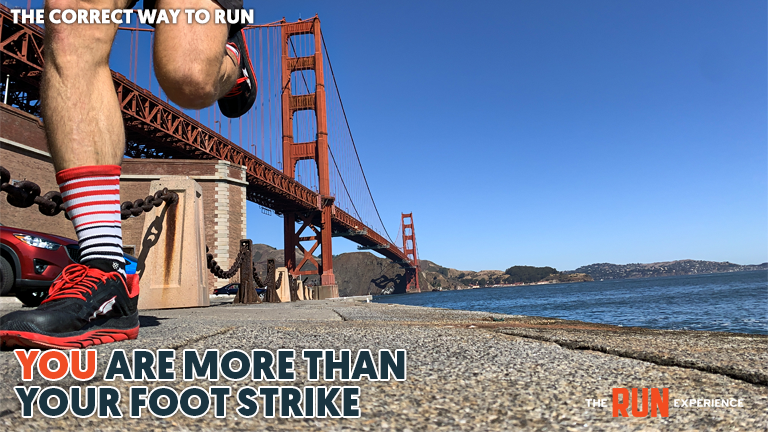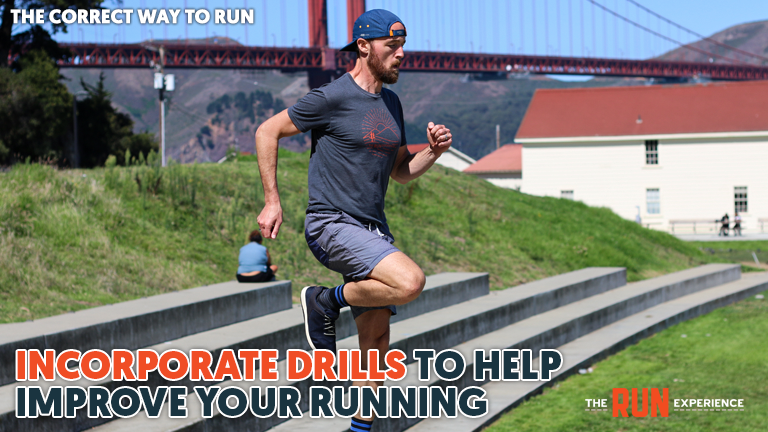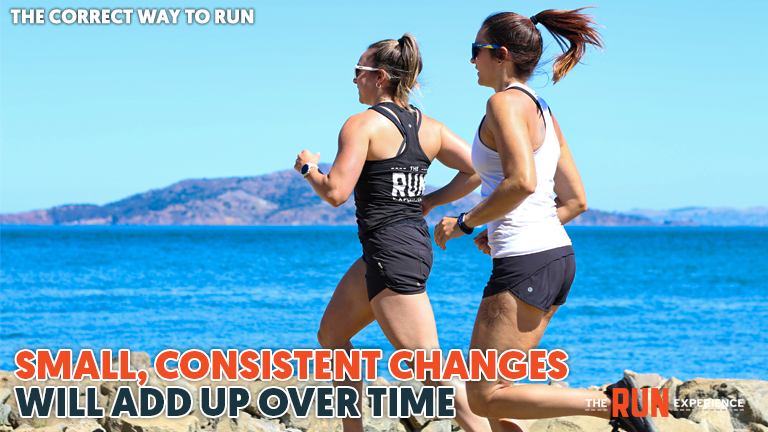Best Way to Run: Learn How to Run the Right Way
The best way to run is about more than just your foot strike. Learn running posture and our favorite drills to improve your running form.

What’s the best way to run? Can you learn how to run the right way?
Running is as natural as breathing, right? Well, not always. Whether you're a seasoned marathoner or a weekend jogger, the quest for the 'perfect' running form is a journey filled with questions and nuances. At The Run Experience, we understand that every runner's stride is as unique as their fingerprint, yet there's a universal craving to run more efficiently, more powerfully, and most importantly, injury-free.
So, how do you run the 'right' way? Is there even such a thing as a one-size-fits-all approach to running? If you've ever caught a glimpse of yourself in a race photo and winced, or if the term 'heel striker' sounds all too familiar, this is where your journey to refining your run begins.
In this guide, we're not just going to talk about foot strikes or the latest trendy running gear. Instead, we'll delve into the holistic essence of running—from the importance of posture to the subtleties of footwork. We'll share practical, easy-to-implement drills that harken back to the days when running was just...running.
Remember those carefree childhood sprints? We're going to help you recapture that natural ease, enhancing your running form with a blend of science, experience, and a touch of nostalgia.
Is There a Best Way to Run?
When it comes to running, it's important to recognize that there is no singular 'best' way to run that suits everyone. Each runner's body is unique, with different strengths, weaknesses, and biomechanics. What works exceptionally well for one person might not be effective for another. This diversity in running styles is not just normal—it's something to be embraced.
While there's no one-size-fits-all technique, there are certainly best practices that all runners can benefit from. These include maintaining a good posture, ensuring proper foot strike, and keeping a balanced stride. However, the application of these principles can vary greatly among individuals. What's essential is to find a balance between following best practices and listening to your body.
In your pursuit of the ideal running form, it's important to steer clear of common mistakes. Overstriding, heel striking with excessive force, or ignoring pain can lead to injuries and setbacks. However, the correction of these mistakes should be adapted to your personal running style and physical capabilities.
Finding the best way for you to run often involves a bit of trial and error. Experimenting with different techniques, adjusting your stride, or even changing your running shoes can all have significant impacts on your comfort and performance. The key is to make these changes gradually and to pay close attention to how your body responds.
Your body is an excellent guide in determining the most suitable running style for you. Pay attention to any signs of discomfort or pain, as these are indicators that something in your current running form might need adjustment. Equally, when a certain style or technique feels good and improves your performance, it's a sign that you're on the right track.
The Correct Way to Run
Making smart alterations to your running form and technique is not a one-and-done process. Starting down the road on the correct way to run means making small changes over longer periods of time. Methodical and sustainable change will bring us back to our natural running abilities and take away the urge to overcomplicate things.
As you read through the following tips and drills, try to keep an image in your head. Visualize yourself running around as a kid. You didn’t think about exactly how your foot was hitting the ground or try to control your arms. Running was natural. Our goal here is to recreate that ease of movement to lead you to better running with some basic cues to help you get there.
Learn From Your Feet

It’s a common trend for runners to go straight to changing their foot strike when digging into the correct way to run. Maybe they’ve been told they’re a “heel striker” or they read a book about barefoot running. While it is helpful to know what you’re feet are doing, they’re only one part of the entire running body.
Probably the most well-known description of an incorrect way to run is to be called a “heel striker.” This looks like a runner who may be overstriding and swinging their foot out in front of their body as they run. Then, as their foot hits the ground, it’s the heel that makes contact first.
Landing this way can mean that there is a greater force of impact traveling from your foot, to your knee, to your hips, and up to your lower back. Apply that force over and over again and you might be feeling a bit achy by the end of your run.
The other end of the spectrum is the forefoot strike. This foot strike is for the runner that tends to land on and push off with the ball of their foot while running. Their heel doesn’t really make any contact at all with the ground. The problem here is that the landing impact is now largely absorbed by your forefoot, ankles, and calves. By the end of your run, your calves will likely be super tight and your Achilles complaining from the overuse.
The “Goldilocks” of foot strikes is said to be a midfoot landing. Not too far back, not too far forward. This is considered to be the ideal landing in the correct way to run because it absorbs the impact of your body weight hitting the ground. It also allows for some good spring into the next stride.
Running Correctly Starts With Your Posture
Now, before you go and try to change the way your foot hits the ground, the following drills will help you make improvements to your entire running form, not just your feet.
An easy way to do this is to look at your posture. We’ve heard it a million times that sitting all day and slouching over our phones is doing damage to our health. Our running form doesn’t escape these effects, either.
When you’re seated in a chair or in the car, your legs are bent in front of you at a 90-degree angle. The hip flexors, or the front of your hips, are in a shortened, inactive position. When you then stand or walk, those flexors may feel tight or stiff. Worse, when you’re running you may lose some range of motion in your stride because your leg can’t open up fully behind you, taking you further away from proper running form.
Your glutes, the biggest muscle in your body, are also more likely to be snoozing on the job when you sit a lot. They don’t need to be engaged to support and stabilize the pelvis when seated. Unfortunately, this can carry over when you’re standing or running.
As a result, your hamstrings or lower back muscles can compensate, which leads to a whole host of problems. Lower back pain, hamstring cramps, low cadence, yes, even heel striking can show up as symptoms of too much sitting.
Don’t despair! You’re not alone, and we’ve got a few simple drills for you to start to incorporate into your training to help bring some awareness to your posture and how this translates to a more correct way to run.
4 Favorite Drills To Practice The Correct Way To Run

The following drills will bring awareness to your posture and the optimal way for your body to move while on a run.
1. Posture drills
By starting off in a well-aligned position, you avoid scenarios such as your head coming forward of your shoulders or your hips leaning excessively ahead of your hips. Those scenarios could very well lead to aches and pain as well as an inefficient running technique.
- Stop to think if your entire body looks stacked.
- Can you visualize a straight line from your ears to your shoulder, down to your hips, knees, and feet?
Remember, this is a slow and steady process! If you notice that your default position is to arch your lower back while standing, then that’s where you’re at. This is about awareness. Bringing about change will take time and repetition before it’s reflexive to stand in an improved position.
2. Heel-toe rocks
After all, we don’t stay in a straight line when we’re running.
- From your starting position, start to rock back and forth on your toes.
- The rock should initiate from your hips moving forward, not from tipping your upper body back and forth.
- Rock far enough forward and you’ll need to take a step to catch yourself.
This drill will emphasize the momentum you can gain with a little forward lean in your hips, leading to more efficient running. Furthermore, you’ll notice your glutes engage as you rock forward. We mentioned earlier how your glutes tend to turn off with excessive sitting. Well, this drill is a great start to turning them back on.
3. Pulling drills
This drill will make you look a bit like a prancing horse. But with good reason! Running isn’t just pushing off the ground, but also about pulling your foot up and forward for the next stride.
- Focus on using the hips and hamstrings to draw the leg up–not just the quads.
- Start by practicing while just standing, then move to jogging in place and practicing a few pulls on each leg.
- You can then alternate between legs while jogging in place, and progress to running a few yards while alternating pulling drills on each leg.
- Form tip: split the difference between a high knee and a butt kick.
4. Bouncing drills
You’ll also be able to pay more attention to what a quick, light landing will feel like while on the run.
- With slightly bent knees (no locked knees!) start to bounce gently in place.
- Allow your heels to slightly kiss the ground in each bounce.
- Optional add on: Move from bouncing into a couple of heel-toe rocks, or from bouncing into pulling drills.
For even more of our favorite drills, check out this video with Coach Holly:
Slow and Steady Wins the Race
It’s worth repeating that you don’t want to make drastic changes to your running form and technique all at once. Small, consistent doses over time will result in lasting change with reduced risk of injury.

Another reason to regularly add these drills to your normal routine is that the more you practice these drills, the more natural they’ll feel. You might feel super awkward the first time you stand there bouncing before you start running. We get it! For this reason, frequent, brief practice is best.
Here’s how you can get started. Choose one drill to add to your run during the first and last 10 minutes. Within those 10 minutes, stop every few minutes and practice your drill of choice and run normally between sessions. By integrating the drills into your run, rather than practicing them in isolation, it’s more likely to feel like a natural, reflexive movement.
If you’re on your weekend long run, you can throw these drills in more often, such as every 30 minutes or so. Even better, throw in some squats and push-ups before the drills to really wake up your system and hit the reset button.
Save the Overhaul For Your Off-Season
If you feel like your running really does need an overhaul, choose a time outside of your current race preparation cycle. You don’t want to throw off your race training by suddenly shifting focus and changing the way you run.
Instead, wait for your off-season, and consider cutting your mileage by 50%. It may sound extreme, but cutting back your running volume significantly will give you time to really implement change. Your body will be able to absorb the practice and put it to work in shorter, higher quality runs.
This is also a great time to work on any running injuries or nagging pains that may have cropped up during your training. Regular mobility work, strength training, and further running drills are all possible ways to add to your training and really dial in the correct way to run.
What’s the Best Way to Run?
There’s not a single one-way-fits-all way to run. Every body type is different, and that leads to different running forms that work for different people. Some runners have longer legs, while others have tighter hips. Others might have limited toe or ankle range of motion, while others are super flexible. This all impacts the way we run.
Don’t try to fit the mold of a perfect running form. It doesn’t exist. Instead, find the correct way to run for you.
For even more training guidance, workouts, and community, download our app and see what’s new at The Run Experience!
